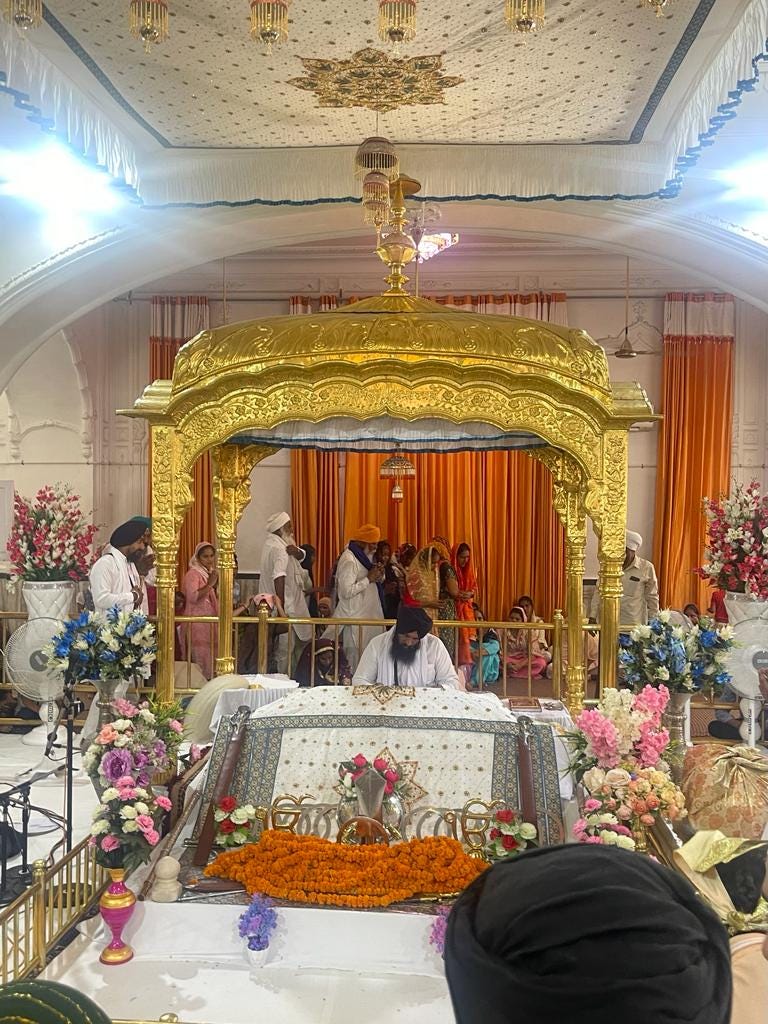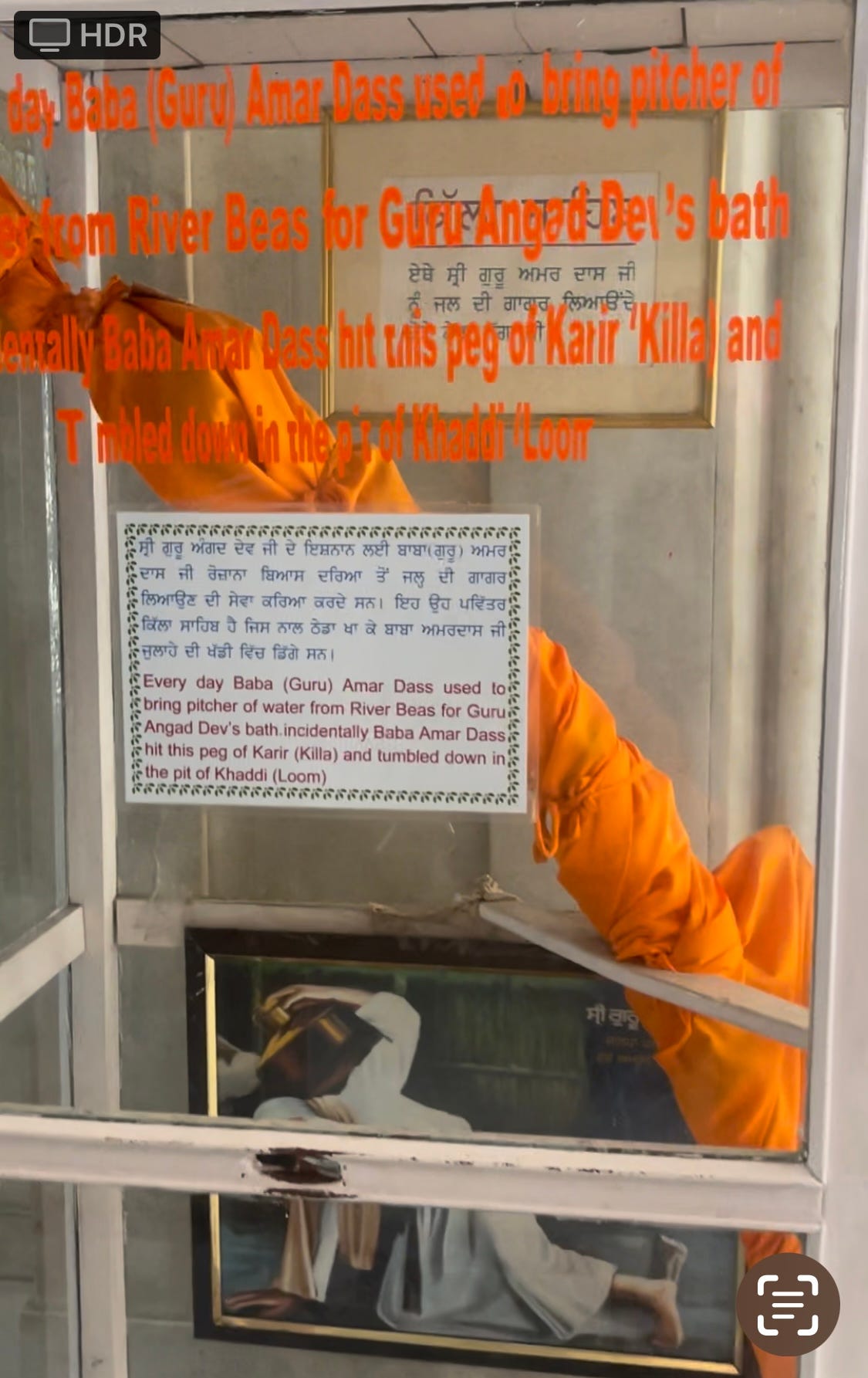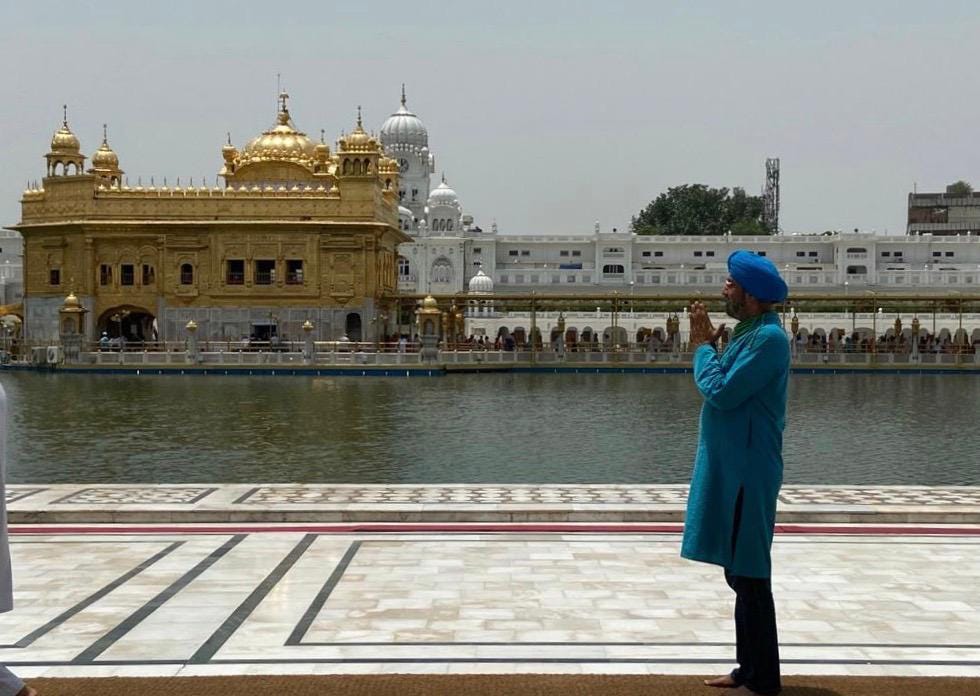Anand Sahib: An Ode to Spiritual Bliss
"Anand Sahib", enshrined within the Guru Granth Sahib, is a timeless composition by Guru Amar Das Ji, the third Sikh Guru. It effortlessly encapsulates the profound joy and serenity derived from an unwavering bond with the Divine. The term "Anand", signifying "bliss", paints a vivid picture of the eternal ecstasy experienced by seekers deeply connected to their spiritual roots. Comprising 40 pauris (stanzas), each 5-verse stanza unravels layered spiritual teachings, guiding seekers towards enlightenment.
Within the sacred volumes of the Guru Granth Sahib, Sikhs use the term "Ang", signifying a 'part' or 'limb', in place of "page". This choice reflects the deep reverence Sikhs have for their holy scripture. For them, the Guru Granth Sahib isn't just a book — it embodies the teachings, wisdom, and presence of the ten Sikh Gurus, revered as a living, eternal Guru. Anand Sahib occupies a special place in these sacred pages, spanning Angs 917 to 922.

Not to be confused with “Anand Karaj”
In the daily Sikh observances known as "Nitnem," the Anand Sahib holds an irreplaceable position. Beyond these daily recitations, its importance permeates major Sikh ceremonies. The "Anand Karaj" is a prime example. This matrimonial ceremony, not to be confused with the Anand Sahib paath itself, represents the sanctified bond of marriage. During this ritual, the bride and groom circumambulate the holy Guru Granth Sahib four times. As they take each round, one of the four Lavaan hymns, penned by Guru Ram Das Ji, the fourth Sikh Guru, is recited, solemnizing the nuptial rites. These hymns are found in the Guru Granth Sahib on Angs 773-774. The Anand Sahib is recited after the Lavaan, bringing the ceremony to a spiritually uplifting and blissful conclusion. Furthermore, during somber events like the "antim ardas" for the departed or death anniversaries, the Anand Sahib offers solace, hope, and unwavering spiritual strength.
Out of its 40 pauris, typically six are chosen for kirtan: the initial five and the concluding 40th one. This selection encapsulates the essence of this spiritual masterpiece.
Penultimate hymns to be recited
After concluding the Anand Sahib, devotees usually recite the final lines from Japji Sahib by Guru Nanak Dev Ji: "ਜਿਨ੍ਹ੍ਹੀ ਨਾਮੁ ਧਿਆਇਆ, ਗਏ ਮਸਕਤਿ ਘਾਲਿ... ਨਾਨਕ ਤੇ ਮੁਖ ਉਜਲੇ, ਕੇਤੀ ਛੁਟੀ ਨਾਲਿ". This sequence seamlessly bridges compositions by the two revered Sikh Gurus, preparing the devotee for the rites of "ardas" and "hukamnama", further deepening their connection to the Divine.
Raag Ramkali: A Spiritual Symphony
The Anand Sahib paath is traditionally recited in the divine strains of Raag Ramkali. Hailing from the intricate traditions of North Indian classical music, Raag Ramkali conjures feelings of deep serenity and sacredness. Often linked with the tranquil moments before dawn, its melodious notes are emblematic of a spiritual renaissance, ushering in a luminous dawn of inner enlightenment.
In the revered Guru Granth Sahib Ji, hymns are meticulously arranged by raags, magnifying the emotional depth of the verses through their melodies. Raag Ramkali, distinguished for its devotion and introspection, is exemplified in compositions like "Ramkali Ki Vaar," which offers spiritual insights intertwined with historical narratives from Guru Arjan Dev Ji's time. Hymns in this raag guide seekers towards righteousness and communion with the Divine, initiating a deep spiritual journey.

The Gurmukhi inscription "ਰਾਮਕਲੀ ਮਹਲਾ ੩ ਅਨੰਦੁ" showcases this blend of melody and spirituality, signifying its origin from Guru Amar Das Ji, the third Nanak. Raag Ramkali in Sikhism is more than just musical notes; it's a path guiding devotees towards divine enlightenment.
The luminous expanse of the "Anand Sahib," often celebrated as the "Song of Bliss," is a testament to the unmatched spiritual brilliance of Guru Amar Das Ji, the third Sikh Guru. This hymn isn't just a mere collection of verses but is a heartfelt reflection of the Guru's profound immersion in divine ecstasy. Every stanza is a portal, echoing with teachings that can transform lives, filling them with boundless joy, equanimity, and spiritual resonance. Much like how ragas in Indian classical music uplift the soul, each pauri of "Anand Sahib" is a rhythmic pulse, propelling seekers into the deep realms of enlightenment.
Pauri-wise Interpretation
In all humility, as we embark on this sacred expedition into the heart of "Anand Sahib," let us commence with the insights and spiritual nuances present within the first five pauris. Each one will guide us closer to the core essence, preparing us for the grand culmination with the fortieth pauri. This final stanza is not just an ending but a sublime synthesis, drawing together the myriad threads of wisdom and presenting them as a unified tapestry of divine revelation. My humble effort is to share this journey with you. So, let's delve in, allowing the transformative energy of each pauri to enlighten our paths.

1st Pauri
ੴ ਸਤਿਗੁਰ ਪ੍ਰਸਾਦਿ ॥
(Ik▫oaʼnkār saṯgur parsāḏ.)
One Universal Creator God. By The Grace Of The True Guru:
ਅਨੰਦੁ ਭਇਆ ਮੇਰੀ ਮਾਏ ਸਤਿਗੁਰੂ ਮੈ ਪਾਇਆ ॥
(Anand bẖa▫i▫ā merī mā▫e saṯgurū mai pā▫i▫ā.)
I am in ecstasy, O my mother, for I have found my True Guru.
ਸਤਿਗੁਰੁ ਤ ਪਾਇਆ ਸਹਜ ਸੇਤੀ ਮਨਿ ਵਜੀਆ ਵਾਧਾਈਆ ॥
(Saṯgur ṯa pā▫i▫ā sahj seṯī man vajī▫ā vāḏẖā▫ī▫ā.)
I have found the True Guru, with intuitive ease, and my mind vibrates with the music of bliss.
ਰਾਗ ਰਤਨ ਪਰਵਾਰ ਪਰੀਆ ਸਬਦ ਗਾਵਣ ਆਈਆ ॥
(Rāg raṯan parvār parī▫ā sabaḏ gāvaṇ ā▫ī▫ā.)
The jeweled melodies and their related celestial harmonies have come to sing the word of the shabad.
ਸਬਦੋ ਤ ਗਾਵਹੁ ਹਰੀ ਕੇਰਾ ਮਨਿ ਜਿਨੀ ਵਸਾਇਆ ॥
(Sabḏo ṯa gāvhu harī kerā man jinī vasā▫i▫ā.)
The Lord dwells within the minds of those who sing the shabad.
ਕਹੈ ਨਾਨਕੁ ਅਨੰਦੁ ਹੋਆ ਸਤਿਗੁਰੂ ਮੈ ਪਾਇਆ ॥੧॥
(Kahai Nānak anand ho▫ā saṯgurū mai pā▫i▫ā. ||1||)
Says Nanak, I am in ecstasy, for I have found my True Guru. ||1||
Summary of 1st Pauri
The inaugural pauri of the "Anand Sahib" is a masterful prelude, resonating with profound spiritual depth. Composed by Guru Amar Das Ji, it articulates the soul's journey towards divine ecstasy and unwavering joy upon connecting with the True Guru. Serving as both a foundation and a beacon, this pauri establishes the profound themes and spiritual insights that unravel through the subsequent 39 pauris. This meticulous beginning not only captures the essence of the hymn but also beckons the devout to embark on a transformative voyage of enlightenment and boundless spiritual bliss.
2nd Pauri
ਏ ਮਨ ਮੇਰਿਆ ਤੂ ਸਦਾ ਰਹੁ ਹਰਿ ਨਾਲੇ ॥
(Ė man meri▫ā ṯū saḏā rahu har nāle.)
O my mind, remain always with the Lord.
ਹਰਿ ਨਾਲਿ ਰਹੁ ਤੂ ਮੰਨ ਮੇਰੇ ਦੂਖ ਸਭਿ ਵਿਸਾਰਣਾ ॥
(Har nāl rahu ṯū man mere ḏūkẖ sabẖ visārṇā.)
Remain always with the Lord, O my mind, and all sufferings will be forgotten.
ਅੰਗੀਕਾਰੁ ਓਹੁ ਕਰੇ ਤੇਰਾ ਕਾਰਜ ਸਭਿ ਸਵਾਰਣਾ ॥
(Angīkār oh kare ṯerā kāraj sabẖ savārṇā.)
He will accept You as His own, and all your affairs will be perfectly arranged.
ਸਭਨਾ ਗਲਾ ਸਮਰਥੁ ਸੁਆਮੀ ਸੋ ਕਿਉ ਮਨਹੁ ਵਿਸਾਰੇ ॥
(Sabẖnā galā samrath su▫āmī so ki▫o manhu visāre.)
Our Lord and Master is all-powerful to do all things, so why forget Him from your mind?
ਕਹੈ ਨਾਨਕੁ ਮੰਨ ਮੇਰੇ ਸਦਾ ਰਹੁ ਹਰਿ ਨਾਲੇ ॥੨॥
(Kahai Nānak man mere saḏā rahu har nāle.) ||2||
Says Nanak, O my mind, remain always with the Lord. ||2||
Summary of 2nd Pauri
The second pauri of "Anand Sahib" unfurls with an enriched tapestry of wisdom. Guru Amar Das Ji, with poetic finesse and spiritual depth, underscores the cardinal principle of Sikhism: a perpetual communion with the Divine. By immersing one's consciousness in this divine connection, a sanctuary of serenity is discovered amidst life's tempests. This pauri illuminates the path to transcendence, wherein even amidst worldly tribulations, a soul anchored in the Guru's teachings finds solace, strength, and an unwavering joy. It's a poignant reminder of the transformative power of divine remembrance and the boundless grace that envelopes those who tread this sacred path.
3rd Pauri
ਸਾਚੇ ਸਾਹਿਬਾ ਕਿਆ ਨਾਹੀ ਘਰਿ ਤੇਰੈ ॥
(Sācẖe sāhibā ki▫ā nāhī gẖar ṯerai.)
O my True Lord and Master, what is there which is not in Your celestial home?
ਘਰਿ ਤ ਤੇਰੈ ਸਭੁ ਕਿਛੁ ਹੈ ਜਿਸੁ ਦੇਹਿ ਸੁ ਪਾਵਏ ॥
(Gẖar ṯa ṯerai sabẖ kicẖẖ hai jis ḏėh so pāv▫e.)
Everything is in Your home; they receive, unto whom You give.
ਸਦਾ ਸਿਫਤਿ ਸਲਾਹ ਤੇਰੀ ਨਾਮੁ ਮਨਿ ਵਸਾਵਏ ॥
(Saḏā sifaṯ salāh ṯerī nām man vasāva▫e.)
Constantly singing Your Praises and Glories, Your Name is enshrined in the mind.
ਨਾਮੁ ਜਿਨ ਕੈ ਮਨਿ ਵਸਿਆ ਵਾਜੇ ਸਬਦ ਘਨੇਰੇ ॥
(Nām jin kai man vasi▫ā vāje sabaḏ gẖanere.)
The divine melody of the Shabad vibrates for those, within whose minds the Naam abides.
ਕਹੈ ਨਾਨਕੁ ਸਚੇ ਸਾਹਿਬ ਕਿਆ ਨਾਹੀ ਘਰਿ ਤੇਰੈ ॥੩॥
(Kahai Nānak sacẖe sāhib ki▫ā nāhī gẖar ṯerai). ||3||
Says Nanak, O my True Lord and Master, what is there which is not in Your home? ||3||
Summary of 3rd Pauri
The third pauri of the "Anand Sahib" extols the grandeur of the Divine's domain, a realm marked by perfection and profound completeness. Through these verses, Guru Amar Das Ji illuminates the blessings bestowed upon those who cherish the Naam in their hearts: they resonate with a celestial symphony and are graced with deep spiritual insights. This pauri is a powerful reflection of the Guru's unwavering faith in the omnipotent and ever-present Divine.

4th Pauri
ਸਾਚਾ ਨਾਮੁ ਮੇਰਾ ਆਧਾਰੋ ॥
(Sācẖā nām merā āḏẖāro.)
The True Name is my only support.
ਸਾਚੁ ਨਾਮੁ ਅਧਾਰੁ ਮੇਰਾ ਜਿਨਿ ਭੁਖਾ ਸਭਿ ਗਵਾਈਆ ॥
(Sācẖ nām aḏẖār merā jin bẖukẖā sabẖ gavā▫ī▫ā.)
The True Name is my only support; it satisfies all hunger.
ਕਰਿ ਸਾਂਤਿ ਸੁਖ ਮਨਿ ਆਇ ਵਸਿਆ ਜਿਨਿ ਇਛਾ ਸਭਿ ਪੁਜਾਈਆ ॥
(Kar sāʼnṯ sukẖ man ā▫e vasi▫ā jin icẖẖā sabẖ pujā▫ī▫ā.)
It has brought peace and tranquility to my mind; it has fulfilled all my desires.
ਸਦਾ ਕੁਰਬਾਣੁ ਕੀਤਾ ਗੁਰੂ ਵਿਟਹੁ ਜਿਸ ਦੀਆ ਏਹਿ ਵਡਿਆਈਆ ॥
(Saḏā kurbāṇ kīṯā gurū vitahu jis ḏī▫ā ehi vaḏi▫ā▫ī▫ā.)
I am forever a sacrifice to the Guru, who possesses such glorious greatness.
ਕਹੈ ਨਾਨਕੁ ਸੁਣਹੁ ਸੰਤਹੁ ਸਬਦਿ ਧਰਹੁ ਪਿਆਰੋ ॥
(Kahai Nānak suṇhu sanṯahu sabaḏ ḏẖarahu pi▫āro.)
Says Nanak, listen, O Saints; enshrine love for the shabad.
ਸਾਚਾ ਨਾਮੁ ਮੇਰਾ ਆਧਾਰੋ ॥੪॥
(Sācẖā nām merā āḏẖāro.) ||4||
The True Name is my only support. ||4||
Summary of 4th Pauri
The fourth pauri of "Anand Sahib" profoundly illustrates Guru Amar Das Ji's deep reliance on the "True Name." (God’s Name). It reverberates with the belief that this divine epithet can satiate spiritual yearnings, instill tranquility, and answer the soul's profound calls. Through the hymn, the Guru's magnanimity shines, as he illuminates the path, urging disciples to cherish the divine Shabad. The recurrent affirmation, "The True Name is my only support," underscores this cornerstone of faith.
5th Pauri
ਵਾਜੇ ਪੰਚ ਸਬਦ ਤਿਤੁ ਘਰਿ ਸਭਾਗੈ ॥
(vāje pancẖ sabaḏ ṯiṯ gẖar sabẖāgai.)
The Panch Shabad, the five primal sounds, vibrate in that blessed house.
ਘਰਿ ਸਭਾਗੈ ਸਬਦ ਵਾਜੇ ਕਲਾ ਜਿਤੁ ਘਰਿ ਧਾਰੀਆ ॥
(Gẖar sabẖāgai sabaḏ vāje kalā jiṯ gẖar ḏẖārī▫ā.)
In that blessed house, the Shabad vibrates; He infuses His almighty power into it.
ਪੰਚ ਦੂਤ ਤੁਧੁ ਵਸਿ ਕੀਤੇ ਕਾਲੁ ਕੰਟਕੁ ਮਾਰਿਆ ॥
(Pancẖ ḏūṯ ṯuḏẖ vas kīṯe kāl kantak māri▫ā.)
Through You, we subdue the five demons of desire, and slay Death, the torturer.
Note: The "five demons" traditionally refer to the five cardinal sins or vices in Sikhism - lust, rage, greed, attachment, and ego.
ਧੁਰਿ ਕਰਮਿ ਪਾਇਆ ਤੁਧੁ ਜਿਨ ਕਉ ਸਿ ਨਾਮਿ ਹਰਿ ਕੈ ਲਾਗੇ ॥
(Ḏẖur karam pā▫i▫ā ṯuḏẖ jin ka▫o sė nām har kai lāge.)
Those who have such pre-ordained destiny are attached to the Lord's Name.
ਕਹੈ ਨਾਨਕੁ ਤਹ ਸੁਖੁ ਹੋਆ ਤਿਤੁ ਘਰਿ ਅਨਹਦ ਵਾਜੇ ॥੫॥
(Kahai Nānak ṯah sukẖ ho▫ā ṯiṯ gẖar anhaḏ vāje.) ||5||
Says Nanak, they are at peace, and the unstruck sound current vibrates within their homes.
Summary of 5th Pauri
In the fifth pauri, Guru Amar Das Ji elucidates the profound experience of the "Anhad" or "unstruck sound". This is not merely a sound but a divine melody that resonates deep within those who have been spiritually awakened. It's akin to an inner beacon, shining its radiant light, casting away inner vices and fears of transience. The very essence of this "unstruck sound" lies in its spontaneous emergence, without any external impetus, symbolizing an unmediated, direct communion with the Divine. Guru Ji emphasizes that those who attune their consciousness to this divine sound, rooted deeply in the Lord's name, navigate life's journey enveloped in an aura of inner tranquility and harmonious alignment with the cosmos.

40th Pauri, the Final Pauri
After our humble endeavour to elucidate the first five pauris, we fast forward to the 40th, the concluding stanza. This pivotal pauri encapsulates the essence of the entire Anand Sahib, distilling its profound wisdom into a singular, resonant message.
ਅਨਦੁ ਸੁਣਹੁ ਵਡਭਾਗੀਹੋ ਸਗਲ ਮਨੋਰਥ ਪੂਰੇ ॥
(Anaḏ suṇhu vadbẖāgīho sagal manorath pūre.)
Listen to the song of bliss, O most fortunate ones; all your longings shall be fulfilled.
ਪਾਰਬ੍ਰਹਮੁ ਪ੍ਰਭੁ ਪਾਇਆ ਉਤਰੇ ਸਗਲ ਵਿਸੂਰੇ ॥
(Pārbarahm parabẖ pā▫i▫ā uṯre sagal visūre.)
I have obtained the Supreme Lord God, and all sorrows have been forgotten.
ਦੂਖ ਰੋਗ ਸੰਤਾਪ ਉਤਰੇ ਸੁਣੀ ਸਚੀ ਬਾਣੀ ॥
(Ḏūkẖ rog sanṯāp uṯre suṇī sacẖī baṇī.)
Pain, illness, and suffering have departed, listening to the True Bani (sacred word or divine teachings).
ਸੰਤ ਸਾਜਨ ਭਏ ਸਰਸੇ ਪੂਰੇ ਗੁਰ ਤੇ ਜਾਣੀ ॥
(Sanṯ sājan bẖa▫e sarse pūre gur ṯe jāṇī.)
The Saints and their friends are in ecstasy, knowing the Perfect Guru.
ਸੁਣਤੇ ਪੁਨੀਤ ਕਹਤੇ ਪਵਿਤੁ ਸਤਿਗੁਰੁ ਰਹਿਆ ਭਰਪੂਰੇ ॥
(Suṇṯe punīṯ kahṯe paviṯ saṯgur rahi▫ā bẖarpūre.)
Pure are the listeners, and pure are the speakers; the True Guru is all-pervading and permeating.
ਬਿਨਵੰਤਿ ਨਾਨਕੁ ਗੁਰ ਚਰਣ ਲਾਗੇ ਵਾਜੇ ਅਨਹਦ ਤੂਰੇ ॥੪੦॥੧॥
(Binvanṯ Nānak gur cẖaraṇ lāge vāje anhaḏ ṯūre.) ||40||1||
Prays Nanak, touching the Guru's Feet, the unstruck sound current of the celestial bugles vibrates and resounds.

Summary of 40th and the Final Pauri
The fortieth and final pauri of the Anand Sahib is a crowning jewel that encapsulates the essence of the entire paath. It brings forth the transformative power of spiritual enlightenment and the invaluable teachings of the Guru. With the divine wisdom of the Guru's Bani, souls embark on a journey of tranquility, joy, and profound fulfillment. The dark clouds of suffering, anguish, and despair are dispelled, making way for an inner radiance of bliss and an enlightened understanding of the Divine. The reference to the "Anhad" or "unstruck sound" holds special significance, alluding to the mystical melody that resonates internally, transcending the physical realm. It is a metaphorical representation of an elevated spiritual state wherein the soul dances in perfect harmony with the universe.

Equanimity in Adversity: The Sikh Way
In the face of adversity, Sikhs often find solace and strength in the profound verses from the Guru Granth Sahib Ji. The words, "ਤੇਰਾ ਕੀਆ ਮੀਠਾ ਲਾਗੈ" (Tera keea meetha laagai), which translate to "Your actions seem sweet to me," have become a beacon of hope and acceptance for many. These words are not just a mantra; they are a testament to the deep-seated belief in the Divine's benevolence and the unwavering faith that even in challenging times, the Divine's plan is one of compassionate grace.
Guru Arjan Dev Ji, in Ang 394 of the Guru Granth Sahib Ji, elaborates on this sentiment. The mentioned verse epitomizes a surrender so profound that every act of the Divine, irrespective of its immediate appearance, is embraced with gratitude. Such acceptance isn't passive resignation but an enlightened recognition of the omnipresent Divine choreography at play in every moment of our lives.
Guru Arjan Dev Ji's deep longing for the "Naam," the name of the Divine, as highlighted in "ਹਰਿ ਨਾਮੁ ਪਦਾਰਥੁ ਨਾਨਕੁ ਮਾਂਗੈ" (Har naam padaarath Nanak maangai), stands as a testament to the soul's eternal quest. This name isn't just a word; it is perceived as the most invaluable treasure, providing unyielding support, solace, and a guidepost for spiritual elevation.
Harmonious Wisdom Across Gurus
The spiritual wisdom espoused by different Sikh Gurus, while individually profound, also interlaces beautifully, resonating harmoniously across their teachings. This resonance is evident when one juxtaposes the verses of Guru Arjan Dev Ji with the Anand Sahib paath, a masterpiece by Guru Amar Das Ji. This harmony is the reason why Anand Sahib, despite its jubilant undertones, also finds its revered place in solemn ceremonies like "Antim Ardas" and Bhog. It's a testament to the Sikh philosophy of perceiving bliss even in solemnity, finding strength in surrender, and seeing grace even in grief1.
Experience Bliss in the Highs as well as Lows of Life
In wrapping up, the "Anand Sahib" paath emerges not just as verses on a page but as a living testament to the enduring spirit of Sikhism. Its teachings are timeless, imparting wisdom on the cyclical nature of life's joys and sorrows, and offering solace in moments of profound introspection. This paath underscores the essence of approaching life's myriad challenges with an unwavering spirit, drawing strength from the Divine. For any seeker, whether from the Sikh community or beyond, it provides a blueprint for navigating life's journey with grace, resilience, and an ever-present connection to the Divine. It beckons one towards the path of inner harmony, leading to the attainment of everlasting bliss throughout the entire course of life2.
Khadoor Sahib's Sanctified Path: Connection with Eight Sikh Gurus and the Birth of Gurmukhi Script
Darbar Sahib (Angeetha Sahib), Khadoor Sahib, front view. Heading: An Immersive Journey Through Time: Khadoor Sahib's Sacred Tapestry Introduction: Embarking on a pilgrimage to Khadoor Sahi, I was eager to uncover the layers of Sikh history and spirituality that have shaped this holy town. As a humble Sikh, I felt a deep sense of revere…
9-Storey Bhora Sahib Gurudwara in Baba Bakala: 'Taposthan' of Sri Guru Tegh Bahadur Ji
Introduction: Today, I had the incredible privilege of visiting the sacred Gurdwara Sri Bhora Sahib in Baba Bakala, a town in Amritsar district, steeped in Sikh history and associated with the revered ninth Sikh Guru, Sri Guru Tegh Bahadur Ji. This journey became a virtual spiritual pilgrimage— a profound experience that filled my heart with immense ble…
















🙏🏼🙏🏼🙏🏼